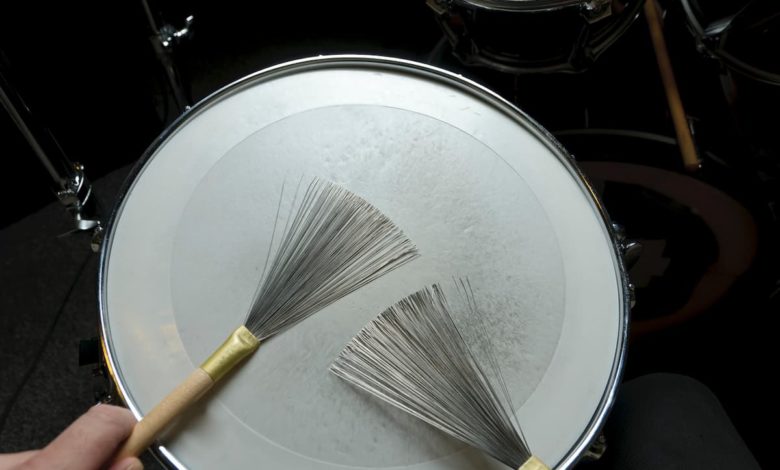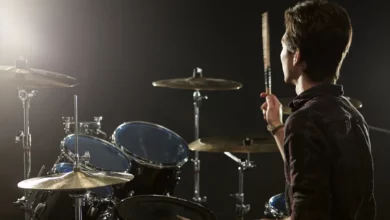
We may earn a commission from the affiliate links on this site. Learn more›
Between metal wires and rubber handles, there’s a lot that goes into choosing the right brushes for your kit.
And to be sure, playing with brushes is a different animal than playing with sticks. There’s no doubt about it. But despite their differences in purpose and function, choosing the right ones isn’t that different from choosing the right sticks.
Here’s a look at how to think about playing brushes, what types of brushes are most common, and what brush playing looks like outside of jazz.
How to Think About Playing Brushes
Like most elements of American music, the history of brushes can be traced back to the early days of jazz. In fact, one of the earliest recordings of brush playing is from Warren “Baby” Dodds on Jelly Roll Morton’s “Mr. Jelly Lord” from 1927.
But because brushes have been associated with jazz for so long, many drummers think brush playing is suitable ONLY for jazz.
In turn, this association has caused those drummers to underestimate (and largely ignore) brushes as a legitimately versatile tool for finding and creating a unique sound on the kit.
And creatively, this is a problem. After all, experimenting with sound is the basis of how you find YOUR sound to begin with. It’s the basis of finding what makes your playing yours.
So instead of thinking of brushes as a tool for jazz drummers, think of it as a tool that jazz drummers happen to have used often but that also has the potential to help you find the sound you’ve been looking for all along.
Types of Brushes
There are a few different types of brushes to choose from. Let’s take a look.
Wire Brushes
Wire (specifically metal) brushes are by far the most popular ones on the market. These give you a crisp yet silky swish sound on the snare and a bright, metallic sound on the cymbals.
The gauge, or thickness, of the wires can also change the quality of these sounds to a certain degree. The spread, or width of the wires from one end to the other, will change them too.
But because wire gauges tend to be really thin, they can also snag on the surface of new coated heads as you sweep for that swishy jazz sound. In fact, Steve Gadd worked with Vic Firth to create a signature brush that avoids this problem with wires bent slightly upwards at the tips.
Nylon Brushes
Unlike the crisp, metallic sound of wire brushes, nylon (or plastic) brushes give you a deeper, warmer sound on the snare and cymbals. This is largely because the material is heavier and thicker.
And because it’s heavier and thicker, you get more volume and slap out of them, especially on the backbeat. Another benefit of nylon brushes is that they’re far less likely to snag on your coated snare head in the way that wire brushes often do.
Retractable Brushes
With retractable brushes, you can pull the wire or nylon into the handle. This not only saves space in your stick bag, but it keeps the brush material from getting damaged or bent.
Yet it also lets you control the spread of the wire or nylon. For example, if you pull them halfway into the handle, you bunch them closer together for a heavier attack when you play.
When you do this, you also don’t have to worry as much about the wires hitting each other and rattling, which is why Joe Calato of Regal Tip invented retractable brushes to begin with.
Brush Handles
Brush handles usually come in either rubber, plastic, or wood. And although they don’t affect the sound of the brushes, they do affect the weight and overall feel.
And nearly every stick brand makes brushes in all three handle types. Popular options in each type include the Vic Firth Heritage Brush (rubber), the ProMark Heavy Brush (plastic), and the Vic Firth Legacy Brush (wood).
Choosing the Right Brushes
When you use brushes, you have different goals than when you’re using sticks. With brushes, you’re trying to be quieter and softer while also giving the music itself a different sound.
But despite these differences, choosing the right brushes isn’t much different from choosing the right sticks. In fact, what you’re looking for — or the big question you’re trying to answer — is exactly the same for both: “Is it letting me do what I want to do?”
For brushes, you’re looking to check off the same boxes of sound, response, and weight as you are with sticks. Together, these make up the “feel” of the brush and stick.
So if using brushes intimidates you or if not being a “jazz drummer” sidelines you from even using them in the first place, remember that your checklist for choosing a brush is ultimately the same as if you were choosing a stick.
This takes the pressure off and frees you up to actually take brushes seriously no matter your genre.
Examples of Brush Playing Outside of Jazz
When you think brush playing, you think jazz. But you shouldn’t think ONLY jazz. Because with brushes, you can give a groove a completely different feel, which changes the sound of the entire song, not just the sound of the kit.
For example, listen to Clayton Cameron’s brush work on John Mayer’s “Belief.” Without that scratchy, shaky 16th note element, the track loses something highly distinct and recognizable about it.
Now listen to what Chris Turner briefly does on “Escapist” by Oceans Ate Alaska. (I suggest watching this whole video of him playing, but he picks up the brushes at the 3:27 mark.) That loose, airy sound is just lovely, but you can’t get it with sticks.
Zooming out a bit, watch Florian Alexandru-Zorn’s Drumeo lesson, “Brushes In Modern Drumming.” If you’ve never used brushes before, you’ll want to order a pair immediately after hearing what Florian can do with them.
The Big Takeaway
The fact that you can see the names Jelly Roll Morton, John Mayer, and Oceans Ate Alaska in the same article — which might never be done again in human history — should say a lot about what brushes can do for your playing.
And it does. It speaks mostly to their versatility. But it also speaks to the range of musical contexts in which drummers across all genres trust them to give the song a unique identity and feel.
The best part? They can do the same for you too.



